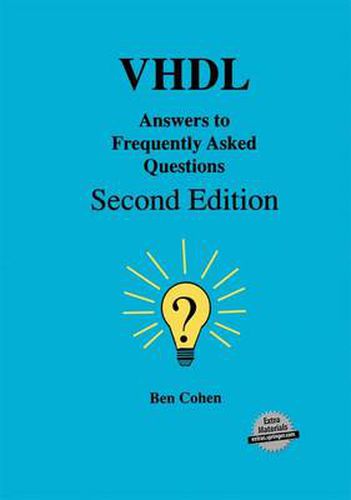Readings Newsletter
Become a Readings Member to make your shopping experience even easier.
Sign in or sign up for free!
You’re not far away from qualifying for FREE standard shipping within Australia
You’ve qualified for FREE standard shipping within Australia
The cart is loading…






This title is printed to order. This book may have been self-published. If so, we cannot guarantee the quality of the content. In the main most books will have gone through the editing process however some may not. We therefore suggest that you be aware of this before ordering this book. If in doubt check either the author or publisher’s details as we are unable to accept any returns unless they are faulty. Please contact us if you have any questions.
This volume is a follow up to the author’s books, VHDL Answers to Frequently Asked Questions (ISBN 0-7923-9791-6) and VHDL Coding Styles and Methodologies (ISBN 0-7923-9598-0). It addresses: misinterpretations in the use of the language; methods for writing error-free, and simulation-efficient, code for testbench designs and for synthesis; and general principles and guidelines for design verification. This second edition includes the following additions: a new chapter on design for reuse that defines coding and design techniques that are impermeable to new technologies and are malleable to new requirements; more questions and answers including discussions on applications of guarded signals and shared variables; and more models including the design of a reusable priority encoder, and a switch; more packages including an enhancement of image package to convert values to text strings in binary, hexadecimal, and decimal formats, and the complex package that defines complex numbers and overloaded operators. The text emphasizes real VHDL, rather than philosophical or introductory types of information; emphasizes application of VHDL for synthesis; uses complete examples to demonstrate problems and solutions; provides a disk that includes all the book examples and other useful VHDL reference material; uses easy to remember symbology notation to emphasize language rules, good and poor methodology and coding styles; identifies obsolete VHDL constructs that must be avoided; identifies synthesizable/non-synthesizable structures; and uses a question and answer format to clarify and emphasize the concerns of VHDL users.
$9.00 standard shipping within Australia
FREE standard shipping within Australia for orders over $100.00
Express & International shipping calculated at checkout
This title is printed to order. This book may have been self-published. If so, we cannot guarantee the quality of the content. In the main most books will have gone through the editing process however some may not. We therefore suggest that you be aware of this before ordering this book. If in doubt check either the author or publisher’s details as we are unable to accept any returns unless they are faulty. Please contact us if you have any questions.
This volume is a follow up to the author’s books, VHDL Answers to Frequently Asked Questions (ISBN 0-7923-9791-6) and VHDL Coding Styles and Methodologies (ISBN 0-7923-9598-0). It addresses: misinterpretations in the use of the language; methods for writing error-free, and simulation-efficient, code for testbench designs and for synthesis; and general principles and guidelines for design verification. This second edition includes the following additions: a new chapter on design for reuse that defines coding and design techniques that are impermeable to new technologies and are malleable to new requirements; more questions and answers including discussions on applications of guarded signals and shared variables; and more models including the design of a reusable priority encoder, and a switch; more packages including an enhancement of image package to convert values to text strings in binary, hexadecimal, and decimal formats, and the complex package that defines complex numbers and overloaded operators. The text emphasizes real VHDL, rather than philosophical or introductory types of information; emphasizes application of VHDL for synthesis; uses complete examples to demonstrate problems and solutions; provides a disk that includes all the book examples and other useful VHDL reference material; uses easy to remember symbology notation to emphasize language rules, good and poor methodology and coding styles; identifies obsolete VHDL constructs that must be avoided; identifies synthesizable/non-synthesizable structures; and uses a question and answer format to clarify and emphasize the concerns of VHDL users.